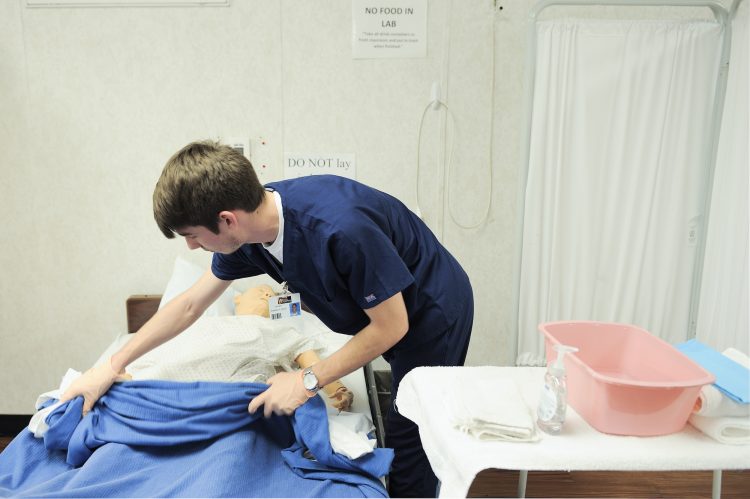Too many American high schoolers are pushed into college preparatory tracks that limit their career choices or ultimately lead to crippling student loan debt.
But students aren’t the only ones who lose out from a one-size-fits-all high school approach. So does the U.S. job market, which faces a significant skilled labor shortage.
A startling 3 million skilled trades jobs will sit unfilled by 2028. Traditional public schools alone aren’t responsible for the student debt or skilled labor crises — but a longstanding Massachusetts education experiment has shown promise at addressing both.
Vocational-technical high schools — or “voc-techs” as they are known — combine academic classes with on-the-job technical training. Voc-tech students graduate with industry-recognized credentials and the ability to pursue college if they choose. Every year, Bay State voc-techs are so popular that there are long waitlists for students who wish to attend.
There’s no reason that Massachusetts alone should hold the recipe for successful vocational-technical education. Schools around the country can enjoy the same success and popularity by importing three major pillars of the Bay State’s voc-tech model.
The first key to success is a schedule that allows students to spend one full week in vocational instruction and the next full week in academic classes. This unique 50-50 split allows students to participate in day-long projects and learning experiences in their communities without having to worry about the next class period cutting their time short.
Students aren’t the only ones who lose out from a one-size-fits-all high school approach. So does the U.S. job market, which faces a significant skilled labor shortage.
The second key is partnering with the local business and industry community. Business leaders can offer students co-op opportunities — paid, part-time work while they are still enrolled in high school — and a bridge to jobs following graduation. They can also donate equipment and serve on advisory boards to ensure that schools’ technical education classes meet industry standards.
Business partnerships are especially important amid recession concerns. A student’s work with a local business during the school day could mean the difference between unemployment and a well-paying job after graduation.
The third key to success is maintaining a degree of autonomy from local school districts. Budget autonomy allows schools to allocate funding as they see fit to meet the needs of their particular students.
Autonomy also allows schools to determine what type of admissions policies work best for them. Some districts mandate lottery admission processes — but voc-tech schools often prefer to review students’ disciplinary and attendance records before admitting them.
Why? The stakes at voc-techs are high. For instance, if a student engages in horseplay while holding a welding torch, students and teachers could be put at risk.
Related: PROOF POINTS: Shop class sometimes boosts college going, Massachusetts study finds
There’s significant evidence that these pillars produce successful voc-tech students. Today, 50 percent of Bay State vocational-technical graduates intend to go on to higher education. A report from the Massachusetts Business Alliance for Education found that among employers in the Bay State with knowledge of vocational schools, “there was general agreement that vocational school graduates are more job-ready than general education or college preparatory high school graduates.”
Meanwhile, the overall dropout rate at regional voc-techs is 0.5 percent, even lower than the overall 1.5 percent statewide dropout rate, according to 2020-21 Massachusetts Department of Elementary and Secondary Education data, and special needs students fare particularly well at voc-tech schools. Voc-techs enroll more special needs students than traditional Bay State high schools, and those students show impressive academic growth from ninth grade on.
Other states would do well to learn from the Massachusetts vocational-technical school model. Importing what the Bay State does right could allow leaders to slash student college debt and reduce the shortage of skilled workers in key economic sectors.
David J. Ferreira is a career vocational-technical teacher, coordinator, principal and superintendent and served as executive director of the Massachusetts Association of Vocational Administrators. Chris Sinacola is a former newspaper editor and the author of five books. Ferreira and Sinacola are co-authors of the book “Hands-On Achievement” and a corresponding toolkit on the voc-tech model.
This story about vocational-tech schools was produced by The Hechinger Report, a nonprofit, independent news organization focused on inequality and innovation in education. Sign up for Hechinger’s newsletter.
Related articles
The Hechinger Report provides in-depth, fact-based, unbiased reporting on education that is free to all readers. But that doesn’t mean it’s free to produce. Our work keeps educators and the public informed about pressing issues at schools and on campuses throughout the country. We tell the whole story, even when the details are inconvenient. Help us keep doing that.
Source by hechingerreport.org










